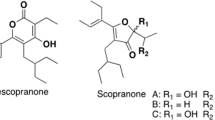Abstract
Ergosterol peroxide, a presumed product of the H_2O_2-dependent enzymatic oxidation of ergosterol, has been isolated from yeast forms of the pathogenic fungus Sporothrix schenckii. The substance, which may have a role in fungal virulence, has been characterized mainly using spectroscopic methods (1H and 13C nuclear magnetic resonance and high resolution mass spectra). The purified compound showed a molecular formula of C_28H_44O_3, displaying characteristic features of epidioxy sterols and was reverted to ergosterol when submitted to S. schenckii enzymatic extract.
Similar content being viewed by others
References
Travassos LR. Sporothrix schenckii. In: Paul J. Szaniszlo (ed.) Fungal dimorphism. New York: Plenum Publishing Corporation, 1985: l21–163.
Cardoso DBS, Angluster J, Travassos LR, Alviano CS. Isolation and characterization of a glucocerebroside (monoglucosylceramide) from Sporothrix schenckii. FEMS Microbiol. Letters 1987; 43: 279–282.
Carlos IZ, Sgarbi DBG, Angluster J, Alviano CS, Silva CL. Detection of cellular immunity with the soluble antigen of the fungus Sporothrix schenckii in the systemic form of the disease. Mycopathologia 1992; 117: 139–144.
Carlos IZ, Zini MMC, Sgarbi DBG, Angluster J, Alviano CS, Silva CL. Disturbances in the production of interleukin1 tumor and necrosis factor in disseminated murine sporotrichosis. Mycopathologia 1994; 127: 189–194.
Schaffner A., Davis CE, Schaffner T, Markert M, Douglas H, Braude AI. In vitro susceptibility of fungi to killing by neutrophil granulocytes discriminates between primary pathogenicity and opportunism. J Clin Invest 1986; 78: 511–524.
Yoshioka A, Miyachi Y, Imamura S, Niwa Y. The effect of the supernatants obtained from Sporothrix schenckii and Candida albicans culture on the generation of reactive oxygen species by polymorphonuclear leukocytes. Mycopathologia 1987; 100: 43–48.
Gunatilaka AAL, Gopichand Y, Schmitz FJ, Djerassi C. Minor and trace sterols in marine invertebrates. 26. Isolation and structure elucidation of nine new 5α, 8α-epidioxy sterols from four marine organisms. J Org Chem 1981; 46: 3860–3866.
Lobo AM, Abreu PM, Prabhakar S, Godinho LS, Jones R, Rzepa HS, Williams DJ. Triterpenoids of the fungus Pisolithus tinctorius. Phytochemistry 1988; 27: 3569–3574.
Jiménez C, Quiñoá E, Rignera R, Vilalta R, Quintela JM. The dietary origin of epidioxy steroids in Actinia equina. A carbon14 incorporation experiment. J Nat Prod 1989; 52: 619–622.
Kahlos K, Kangas L Hiltunen R. Ergosterol peroxide, an active compound from Inonotus radiatus. Planta Medica 1989; 55: 389–390.
Takaishi Y, Adachi R, Murakami Y, Ohashi T, Nakano K, Tomimatso T. A polyoxygenated steroid from Lasiosphaera nipponica. Phytochemistry 1992; 31: 243–246.
Tchouankeu JC, Nyasse B, Tsamo E Sondengam BL, Morin C. An ergostane derivative from the bark of Entandrophragma utile. Phytochemistry 1992; 31: 704–705.
Sheffer M, Fried A, Gottlieb HE, Tietz A, Avron M. Lipid composition of the plasma-membrane of the halotolerant alga, Dunaliella salina. Biochim Biophys Acta 1986; 857: 165–172.
Bates ML, Reid WW, White JD. Duality of pathways in the oxidation of ergosterol to its peroxide in vivo. J Chem Soc Chem Comm 1976; 4445.
Jong SC, Donovick R. Antitumor and antiviral substances from fungi. Adv Appl Microbiol 1989; 34: 183–262.
Svennerhoim L, Fredman P. A procedure for the quantitative isolation of brain gangliosides. Biochim Biophys Acta 1980; 617: 97–109.
Macher BA, Klock JC, Fukuda MN, Fukuda M. Isolation and structural characterization of human lymphocyte and neutrophil gangliosides. J Biol Chem 1981; 256: 1968–1974.
Manocha MS, SanBias G, Centeno S. Lipid composition of Paracoccidioides brasiliensis: Possible correlation with virulence of different strains. J Gen Microbiol 1980; 117: 147–154.
Topham RW, Gaylor JL. Further characterization of the 5α-hydroxysterol dehydrase of yeast. Biochem Biophys Res Comm 1972; 47: 180–186.
Gaylor JL. Biosynthesis of skin sterols. VI. Enzymatic demethylation of lanosterol and lanosta7,24-dien-3βol by homogenates of rat liver. J Biol Chem 1964; 239: 756–761.
Topham RW, Gaylor JL. Anaerobic formation of ergosterol from a 5α-hydroxysterol by cellfree preparations of yeast. Biochem Biophys Res Comm 1967; 27: 644–649.
Takaishi Y, Uda M, Ohashi T, Nakano K, Murakami K, Tomimatso T. Glycosides of ergosterol derivatives from Hericum erinaceus. Phytochemistry 1991; 30: 4117–4120.
Basaga US. Biochemical aspects of free radicals. Biochem Cell Biol 1990; 68: 989–998.
Bilinski T, Litwinska J, Blaszczynski M, Bajus A. Superoxide dismutase deficiency and the toxicity of the products of autooxidation of polyunsaturated fatty acids in yeast. Biochim Biophys Acta 1989; 1001:102–106.
Weete, JD. Structure and function of sterols in fungi. Adv Lipid Res 1989; 23: 115–167.
Walbaum S, Duriez T, Dujardin L, Biguet J. Étude d'un extrait de Sporothrix schenckii (forme levedure). Analyse electrophor étique et immunoelectrophor étique; characterisation des activés enzimatiques. Mycopathologia 1978; 63: 105–111.
Teng JI, Smith LL. Sterol metabolism. XXIV. On the unlikely participation of singlet molecular oxygen in several enzyme oxygenations. J Am Chem Soc 1973; 95: 4060–4061.
Gorman AA, Hamblett I, Rodgers MAJ. Ergosterol (provitamin D2) triplet state: an efficient sensitiser of singlet oxygen, O2 (1Δg), formation. Photochem Photobiol 1987; 45: 215–221.
Niu QJ, Mendenhall GD. Yields of singlet molecular oxygen from peroxyl radical termination. J Am Chem Soc 1992; 114: 165–172.
Topham RW, Gaylor JL. Isolation and purification of a 5α-hydroxysterol dehydrase of yeast. J Biol Chem 1970; 245: 2319–2327.
Author information
Authors and Affiliations
Rights and permissions
About this article
Cite this article
da Graça Sgarbi, D.B., da Silva, A.J.R., Carlos, I.Z. et al. Isolation of ergosterol peroxide and its reversion to ergosterol in the pathogenic fungus Sporothrix schenckii. Mycopathologia 139, 9–14 (1997). https://doi.org/10.1023/A:1006803832164
Issue Date:
DOI: https://doi.org/10.1023/A:1006803832164




